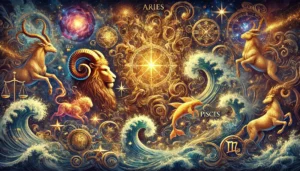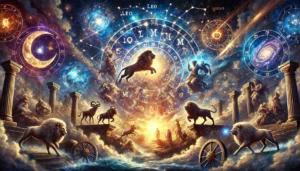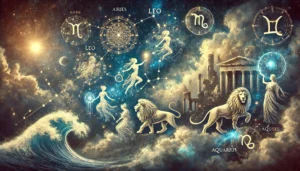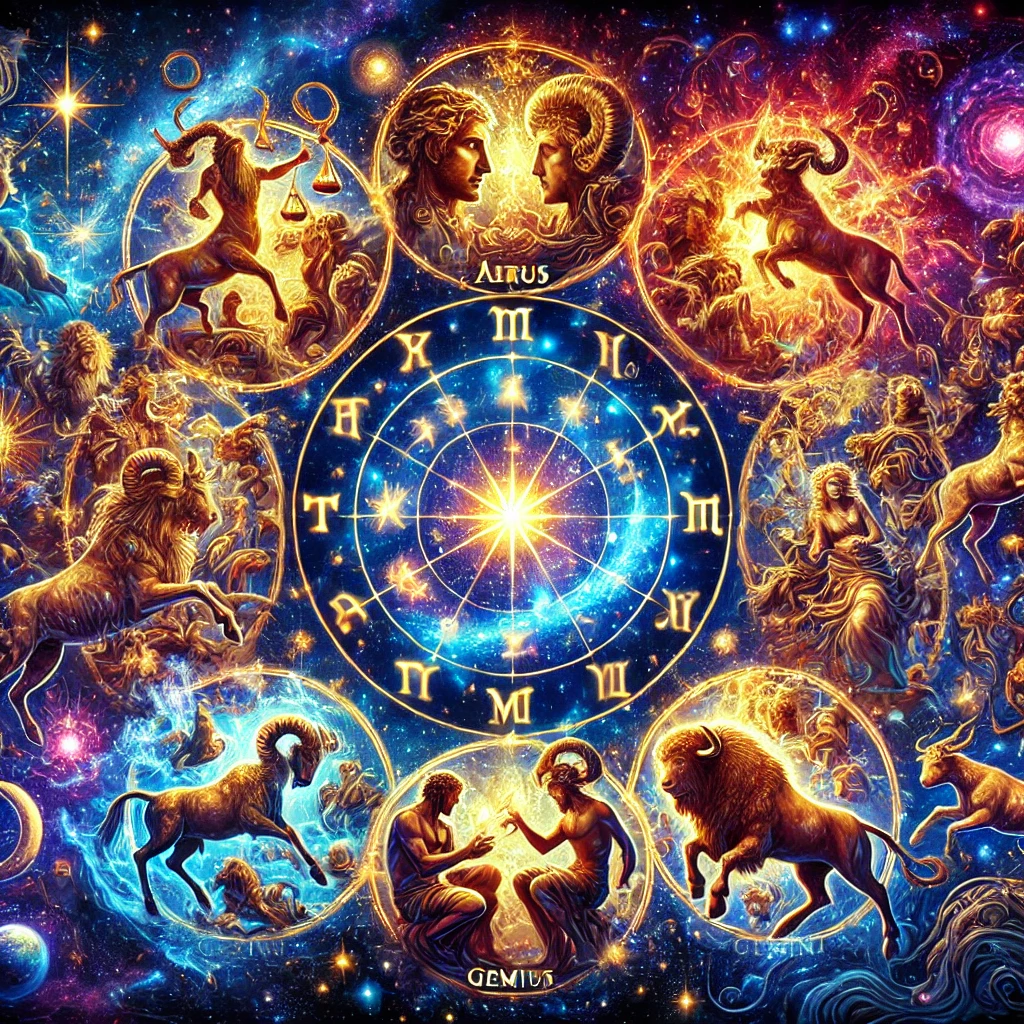
Mythological tales of the zodiac signs
Mythological Origins of Zodiac Signs and Their Stories
The zodiac signs are a testament to humanity’s age-old fascination with the cosmos. Since ancient times, civilizations have observed celestial patterns, ascribing to them meanings and stories that explain the mysteries of existence. The zodiac signs, which form a significant part of astrological traditions, are rooted in rich mythologies that span Greek, Roman, Babylonian, Indian, and other ancient cultures. These signs not only represent constellations but also embody profound symbolic lessons derived from mythological narratives. Here, we delve into the extended myths and explore how each zodiac sign connects to timeless themes of human behavior and spiritual growth.
1. Aries (The Ram): The Golden Fleece and the Quest for Leadership
The story of Aries is deeply tied to the myth of the golden ram, whose fleece became the centerpiece of one of Greek mythology’s greatest quests. The ram, a divine creation of Hermes, symbolized deliverance and leadership. After saving Phrixus and Helle, its golden fleece was hung in a sacred grove guarded by a dragon. This quest for the fleece, undertaken by Jason and the Argonauts, represents Aries’ drive for heroism and leadership. In many ways, Aries’ story teaches the importance of courage, sacrifice, and perseverance in overcoming life’s challenges. The ram is also seen in other cultures, symbolizing spring’s vitality and the renewal of life.
Table of Contents
2. Taurus (The Bull): Guardianship of Earthly Pleasures
Taurus is not only connected to the abduction of Europa but also represents the sacredness of bulls in ancient cultures. In Mesopotamia, the Bull of Heaven was sent by the goddess Ishtar to punish the hero Gilgamesh. Similarly, in Indian mythology, Nandi the bull is Shiva’s vahana (mount) and a symbol of strength and devotion. The bull embodies earthly pleasures, sensuality, and steadfastness. Taurus reminds us to appreciate the beauty of nature and the importance of patience and loyalty in achieving lasting success.

Mythological tales of the zodiac signs
3. Gemini (The Twins): Duality and Immortality
The story of Castor and Pollux, the twins of Gemini, goes beyond their brotherly bond. The twins represent the dual nature of existence—life and death, mortal and immortal, physical and spiritual. While Castor was known for his skills in horse taming, Pollux excelled in combat. Their complementary traits highlight Gemini’s intellectual versatility and adaptability. The myth of the twins also appears in other traditions, such as the Vedic tale of the Ashwini Kumaras, divine twins who represent health and vitality. Gemini serves as a reminder of the balance between dualities in life.
4. Cancer (The Crab): The Quiet Protector
Cancer’s myth emphasizes the value of loyalty and service. Though the crab was crushed by Hercules, its efforts were honored, teaching us that even seemingly small acts of bravery and devotion have cosmic significance. Cancer is deeply tied to themes of home, nurturing, and emotional resilience. In ancient Egyptian mythology, the crab was associated with the scarab beetle, a symbol of rebirth and protection, showing the universal reverence for this sign’s nurturing qualities.
5. Leo (The Lion): The Hero’s Triumph
The constellation of Leo is a tribute to the mighty Nemean lion, whose impenetrable skin required Hercules to rely on his strength and wit. Leo’s connection to the lion underscores themes of pride, leadership, and triumph over adversity. In other cultures, lions often symbolize solar power and kingship. For instance, in Hindu mythology, Narasimha, the lion incarnation of Lord Vishnu, represents divine strength and protection. Leo invites us to embrace our inner power and shine confidently in the world.
6. Virgo (The Maiden): Guardian of Purity and Harvest
Virgo’s myth is deeply intertwined with agricultural cycles and the changing seasons. Astraea, often associated with Virgo, left humanity during the Iron Age, symbolizing the loss of innocence and the rise of human corruption. The connection to Demeter, the goddess of harvest, reflects Virgo’s association with fertility and nurturing life. In ancient Indian astrology, Virgo (Kanya Rashi) is associated with perfection, self-discipline, and service. The maiden reminds us of the importance of purity, diligence, and balance in our relationship with nature and society.

Mythological tales of the zodiac signs
7. Libra (The Scales): The Pursuit of Justice
Libra’s symbol of scales is closely linked to the goddess Astraea and her role as a mediator between good and evil. In Egyptian mythology, the scales represent the weighing of the heart during judgment, overseen by Ma’at, the goddess of truth and balance. Libra emphasizes fairness, diplomacy, and the importance of ethical decision-making. It teaches us to seek equilibrium in relationships and to approach life’s challenges with impartiality and wisdom.
8. Scorpio (The Scorpion): Power and Transformation
The scorpion’s tale, entwined with the story of Orion, highlights the themes of vengeance and transformation. Scorpions have long been regarded as symbols of mystery and power in various cultures. In Indian mythology, the scorpion represents karmic forces that drive inner transformation. Scorpio teaches us the importance of facing our deepest fears and embracing change, even when it feels destructive.
9. Sagittarius (The Archer): The Seeker of Truth
Sagittarius represents the centaur Chiron, a figure of profound wisdom and healing. Chiron’s willingness to endure pain for the greater good exemplifies Sagittarius’ themes of selflessness, exploration, and intellectual growth. In other traditions, the archer is seen as a warrior who aims for spiritual enlightenment, reminding us of our eternal quest for higher truths and purpose.
10. Capricorn (The Sea-Goat): Mastery Through Struggle
Capricorn’s dual nature, part goat and part fish, symbolizes the balance between earthly struggles and spiritual aspirations. Pan’s transformation during his escape from Typhon reflects Capricorn’s resilience and resourcefulness. This sign is also associated with the Hindu deity Varuna, the guardian of cosmic waters. Capricorn reminds us that success comes from persistent effort and the ability to navigate between material and spiritual realms.
11. Aquarius (The Water Bearer): The Giver of Divine Wisdom
Aquarius, the water bearer, signifies the flow of divine knowledge and blessings to humanity. Ganymede’s ascension to the heavens symbolizes the bridging of mortal and divine realms. In Vedic traditions, Aquarius (Kumbha Rashi) is associated with the cosmic churning of the ocean (Samudra Manthan), representing the search for nectar (immortality). Aquarius inspires us to embrace innovation, humanitarianism, and the sharing of wisdom.
12. Pisces (The Fish): Unity and Compassion
The myth of Aphrodite and Eros transforming into fish embodies themes of unity and self-preservation. The cord that tied them together reflects Pisces’ connection to interconnectedness and spirituality. In Indian mythology, Pisces is linked to Matsya, the fish incarnation of Vishnu, who saved humanity and sacred knowledge during a great deluge. Pisces encourages compassion, empathy, and a deep understanding of life’s cycles.

Mythological tales of the zodiac signs
The Universal Connection to the Zodiac
The zodiac’s stories transcend cultures, each adding unique interpretations to the constellations. Babylonian, Chinese, and Native American traditions also reflect cosmic patterns that guide human lives. In Hinduism, the Nakshatras (lunar constellations) complement the zodiac, offering deeper insights into astrology. These narratives remind us of humanity’s eternal connection to the stars, inspiring us to seek purpose, balance, and wisdom.
Conclusion
The mythological origins of the zodiac signs illuminate profound truths about human existence. Through these stories, we find guidance for navigating life’s complexities and understanding our roles in the cosmic order. By looking to the stars, we reconnect with ancient wisdom that continues to shape our collective consciousness, bridging the gap between myth and reality. These timeless tales remind us that, like the constellations, our lives are interconnected, forming a grand celestial tapestry.
FAQs on “Mythological Origins of the Zodiac: Ancient Stories Behind the Stars”
- What is the origin of the zodiac signs?
The zodiac signs trace their origins to ancient civilizations such as Mesopotamia, Greece, India, and China. These cultures observed the movement of celestial bodies and associated them with mythical tales, gods, and symbolic meanings. The 12 zodiac signs we know today stem from Babylonian astrology, which was later adapted by the Greeks and Romans. Indian astrology, or Jyotisha, developed independently but also links constellations to divine and mythological concepts.
- How are zodiac signs connected to mythology?
Each zodiac sign has a rich mythological background tied to ancient stories or deities. For instance:
Aries (the Ram): Linked to the golden ram of Greek mythology that rescued Phrixus and Helle. Its fleece later became the prized “Golden Fleece” in the tale of Jason and the Argonauts.
Leo (the Lion): Represents the Nemean Lion, a fearsome beast slain by Hercules as part of his Twelve Labors.
Pisces (the Fish): Symbolizes the Greek myth of Aphrodite and Eros, who transformed into fish to escape the monstrous Typhon.
Indian astrology connects these signs to celestial energies and deities, such as Simha (Leo) being linked to Surya (the Sun God) or Vrishabha (Taurus) being tied to Nandi, Lord Shiva’s sacred bull. These connections emphasize the spiritual and cosmic nature of the zodiac.
- Are zodiac signs the same across all cultures?
No, zodiac signs and their interpretations vary across cultures. While Western astrology is based on 12 sun signs tied to the Gregorian calendar, Indian astrology (Jyotisha) focuses on lunar constellations (nakshatras) and planetary movements. Chinese astrology has 12 animal zodiac signs based on the lunar calendar, including symbols like the Dragon, Tiger, and Rabbit. Despite differences, these systems often share a common thread: associating human life and events with cosmic patterns.
- What are some famous myths behind the zodiac signs?
Some fascinating myths associated with the zodiac include:
Gemini (the Twins): Represents the Greek myth of Castor and Pollux, twin brothers who became the constellation Gemini after Zeus immortalized their bond.
Sagittarius (the Archer): Associated with Chiron, the wise and compassionate centaur of Greek mythology who mentored heroes like Achilles and Hercules.
Capricorn (the Goat): Represents the Greek sea-goat, Pan, who jumped into the Nile to escape Typhon and transformed into a half-goat, half-fish creature.
Indian astrology also contains stories, such as Mesha (Aries) symbolizing the ram associated with Agni, the fire deity, and Makara (Capricorn) representing a mythical sea creature linked to Lord Varuna, the god of oceans.
- How were zodiac signs used in ancient times?
In ancient civilizations, zodiac signs played an integral role in religious rituals, agricultural planning, and divination. People believed that the positions of celestial bodies at specific times influenced their lives and the world around them. For example:
Farmers used the zodiac to determine the best times for planting and harvesting.
Kings and leaders consulted astrologers to choose auspicious times for wars, coronations, or marriages.
Priests and sages used zodiac alignments to perform sacred ceremonies and predict cosmic events like eclipses.
- What is the connection between Indian and Western zodiac mythology?
Indian (Vedic) astrology and Western astrology share a common foundation in observing the constellations, but their interpretations diverge. Western astrology is based on the tropical zodiac, while Indian astrology uses the sidereal zodiac, which accounts for the Earth’s precession. For example, the Indian Vrishchika (Scorpio) and the Western Scorpio both represent the scorpion but have different mythological associations. Similarly, Vedic astrology incorporates the concept of nakshatras (lunar mansions), adding another layer of complexity.
- Why do zodiac myths remain popular today?
Zodiac myths endure because they offer timeless archetypes and narratives that resonate with human emotions and experiences. They provide a symbolic language for understanding personal traits, relationships, and life challenges. In modern times, astrology blends mythological wisdom with psychological insights, making it relevant for self-discovery and guidance.
- Are zodiac signs purely mythological or rooted in astronomy?
Zodiac signs are a fusion of mythology and astronomy. The constellations are real groups of stars observed in the night sky, but the stories and meanings assigned to them are cultural creations. Astronomers in ancient times observed the movement of the Sun, Moon, and planets through these constellations, which led to the development of astrological systems and myths.
- Do zodiac myths have spiritual significance?
Yes, zodiac myths hold profound spiritual meaning in many cultures. They symbolize universal truths, the cyclical nature of life, and the connection between the cosmos and human existence. For instance:
In Indian astrology, each sign is tied to karmic lessons and spiritual growth.
In Greek mythology, the zodiac constellations represent gods, heroes, and creatures who were immortalized in the stars for their deeds or sacrifices.
- Can zodiac myths still guide us in modern life?
Although astrology is not scientifically proven, zodiac myths and symbols offer valuable insights for introspection and personal growth. They help individuals identify archetypal patterns in their behavior, relationships, and life choices. For example:
Someone influenced by Leo may resonate with qualities like courage and leadership, inspired by the myth of the Nemean Lion.
A person under Virgo might strive for perfection and service, reflecting the myth of Astraea, the goddess of justice.
- How do zodiac myths vary between cultures?
Different cultures have unique zodiac myths shaped by their beliefs and traditions:
Western Mythology: Focuses on Greek and Roman tales of gods and heroes.
Indian Mythology: Ties the zodiac to Vedic deities and cosmic principles, blending spirituality with celestial observations.
Chinese Mythology: Centers on the Jade Emperor’s race, which determined the order of the 12 animal zodiac signs.
Despite their differences, all systems emphasize the cosmic influence on human destiny.
- What lessons do zodiac myths teach us?
Zodiac myths teach universal themes such as courage, resilience, humility, and the interconnectedness of life and the cosmos. They remind us of humanity’s age-old fascination with the stars and the desire to find meaning in the universe. Through these myths, we can explore deeper truths about ourselves and our place in the world.
- How has modern astrology adapted these myths?
Modern astrology often simplifies and reinterprets ancient myths to fit contemporary lifestyles. While the core stories remain, their application has expanded to include psychological profiling, relationship compatibility, and even career guidance. The enduring appeal of these myths lies in their ability to connect ancient wisdom with modern concerns.
These FAQs explore the rich intersection of astronomy, mythology, and spirituality in the zodiac, providing a deeper understanding of how ancient stories continue to influence our lives today.
Summary
The article “Mythological Origins of the Zodiac: Ancient Stories Behind the Stars” explores the fascinating connection between celestial phenomena and mythology. It delves into the origins of the 12 zodiac signs, tracing their roots to ancient cultures like Indian, Greek, and Babylonian civilizations. Each zodiac sign is linked to a mythological tale, often involving gods, heroes, or celestial events, that reflects the characteristics associated with the sign. The article highlights how these stories shaped astrological beliefs and influenced spiritual practices across the world. By unraveling these tales, it provides insight into the enduring legacy of astrology and its deep cultural significance.
Related Articles
- The Tridevi: Lakshmi, Saraswati, and Parvati – Their Roles and Powers
- “Divine Creatures of Ancient Indian Scriptures: Exploring the Role of Animals in the Vedas, Puranas, and Mahabharata”
- Nature and Spirituality: Exploring the Sacred Essence of the Himalayas, Ganga, and Other Natural Wonders”
- “Reviving the Gurukul System: Relevance and Lessons for Modern Education”
- “Exploring Greek and Indian Mythology: Similarities Between Greek and Indian Mythology “
- “Embracing Sattvic Living: Harmonizing Mind, Body, and Soul Through Food and Lifestyle”
- “Charity and Prosperity: Exploring the Concept of Daan and Its Financial Relevance in Modern Life”
- How to Build an Eco-Friendly Home Inspired by Vastu Shastra
- Comparison of Ancient and Modern Sports: How Traditional Sports Have Influenced Contemporary Games
- “Timeless Lessons from Ancient Tales: Linking Samudra Manthan and Ganga’s Descent to Modern Ecological Challenges”
- “Reviving Sanskrit: How AI is Preserving Ancient Languages for the Future”
- “Mathura: The Sacred Land of Lord Krishna’s Divine Leelas”
- Investing for Future Generations: Lessons from Indian Traditions on Legacy Building and Wealth Preservation
- “Ancient Indian Wisdom: Timeless Lessons for Tackling Today’s Climate Crisis”
- “Artificial Intelligence and Spirituality: Transforming Ancient Practices for the Modern World”
- “Gold and Real Estate in India: Timeless Assets Shaping Financial Strategies”
- “Divine Feminine Power in Hindu Mythology: The Legends of Durga, Saraswati, and Lakshmi”
- “Divine Beings of Sanatan Dharma: The Spiritual Significance of Sacred Animals in Hinduism”
- “Symbolism in Mythological Art: Unlocking Hidden Meanings in Ancient Temple Carvings”
- “Exploring Technological Advancements in Ancient India and Civilizations: Vimana, Metallurgy, & Water Management systems”
- Unveiling the Mysteries: Ancient Temples of Sanatan Dharma , Mysterious Temples of India
- “The Scientific Knowledge of Sanatan Dharma: Ancient Wisdom Meets Modern Science”
- Ancient Indian Sports and Games: Celebrating a Legacy of Skill, Strength & Strategy”
- “Exploring the Cosmic Link: The Connection Between Astronomy and Vedic Astrology”
- The Power of Sanskrit: Unlocking the Divine Language of the Gods
- “The End of Kaliyuga: A Sanatan Insight into the World’s Final Chapter”
- Explore more articles on Prachin Sanatan Yuga.
zodiac signs zodiac signs zodiac signs zodiac signs zodiac signs zodiac signs zodiac signs

